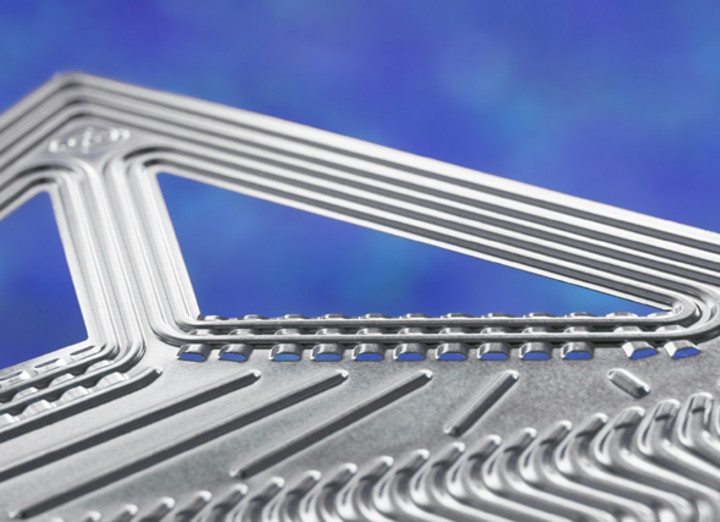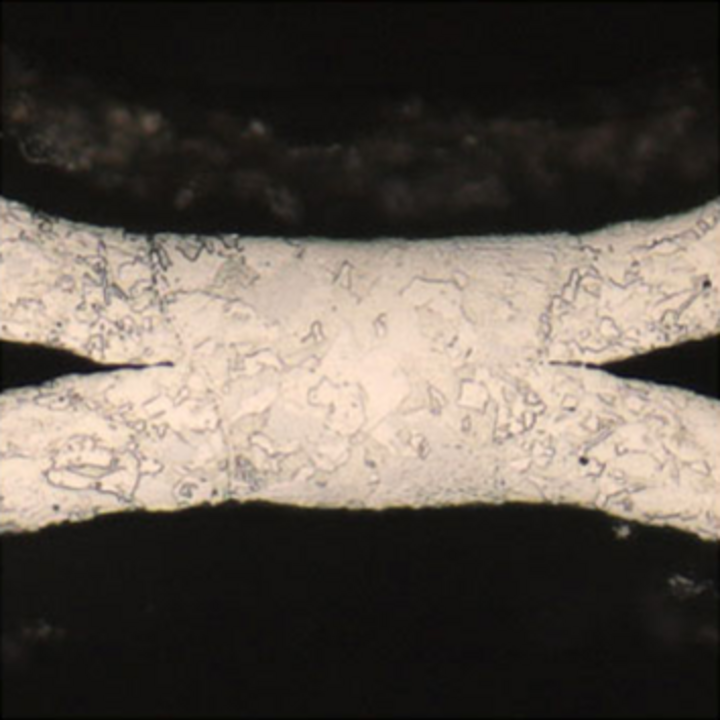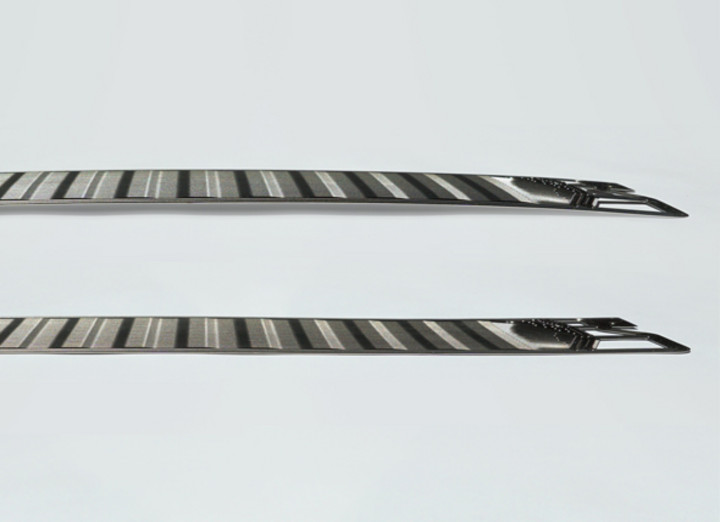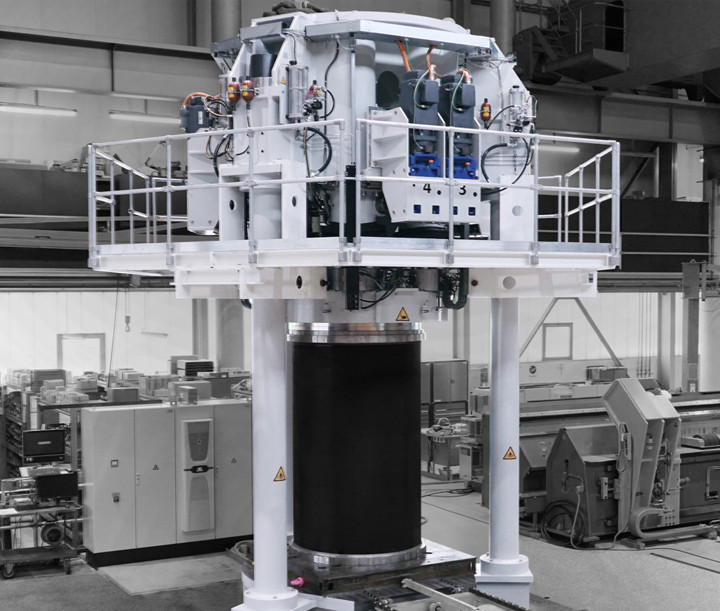Forming

- Material: 1.4301
- Wall thickness: 50 µm
- Pitch: 0.75 mm
- Channel depth: 0.25 mm
- Result: extremely accurate, high repeat accuracy and reproducibility
Based on our core competences forming, cutting, welding and straightening we are one of the first companies to have been involved in research and development of production processes and machines for fuel cell and electrolyzer components, such as metallic bipolar plates, for 20 years.
From engineering through prototyping and small series production in our in-house production laboratory up to customized production lines – we implement solutions tailored to individual market demands.
The fuel cell and the electrolyzer are not only interesting for future mobility, logistics or the generation of electricity and heat for buildings, but also for numerous branches of industry, such as the steel, fertilizer and gas industries, which will depend on the production of large quantities of green hydrogen in the future. This makes them important for all applications of energy generation where environmental aspects, energy efficiency and sustainability are relevant.
At Graebener® Bipolar Plate Technologies we want to make our idea of the future tangible for the present. Not only do we want to create leading and lasting quality for our customers in the spirit of our company's history, we also strive to develop solutions that already provide today what the world needs tomorrow.
We are committed to creating the quality standard for technologies for the production of fuel cell and electrolyzer components and to developing future-oriented processes and machines which help our customers to produce them precisely tailored, integrable, scalable and thus economically efficient.
Thus, we not only develop customized and scalable lines, but also support our customers holistically from the very beginning via engineering, prototyping and small series production of bipolar plates.
The fact that we are good at this is not only proven by our renowned references, network and research partners, but also – quite pragmatically – by more than 90 bipolar plate designs implemented and over 110,000 plates manufactured on our machines.
For detailed information visit the website of our business unit Graebener® Bipolar Plate Technologies.
Hydroforming Press:
As a pioneer in hydroforming, we deliberately rely on the process for which we are known worldwide as experts for the production of bipolar plates. The advantages of hydroforming are obvious: With so-called external high-pressure forming, extremely filigree structures can be realized in series using extremely thin materials from 50 µm. In contrast to mechanical forming, which at first glance may seem more cost-effective, especially for series production, hydroforming offers numerous advantages that pay off in the long term:
Since bipolar plate production is all about repeatable precision, attention to detail and high value, we believe that hydroforming is the optimal process – and one of the quality features that makes Graebener® Bipolar Plate Technologies your sustainable competitive edge.
Cutting and Welding Machines:
Furthermore, as an experienced technology and equipment partner, we are also at your side for the subsequent cutting and welding processes. For precise cutting and welding results, we use state-of-the-art laser technology. To achieve the best results even with the smallest structures, we work with the highest beam qualities. In addition to this, we devote particular attention to the positioning accuracy, repeatability and long-term stability of the machine.
Straightening Machine:
For use in fuel cells and electrolyzers, metallic bipolar plates are stacked and pressed together in stacks of sometimes several hundred plates. In addition to the bipolar plates, extremely sensitive components are also installed. If the bipolar plates are not flat but warped, this leads to an inhomogeneous distribution of pressure between the components as well as microcracks, which have a negative impact on the effectiveness and durability of the stack.
Our specially developed and worldwide unique straightening machine offers for the first time the possibility to produce flat bipolar plates - a necessary requirement for both economical stack production as well as high performance and durability of the stacks.
Stack Press:
The Graebener® stack press supports the technical testing of electrolysis stacks at the end of their production process: The pre-assembled stack, which consists of a large number of plates, is first moved into the machine and then compressed to a defined height until a certain pressure is reached within the stack. This pressure must then be maintained unchanged for several hours. At this time, the stack is subjected to all the necessary technical tests carried out by the customer and with the help of further procedures. These are necessary to confirm its full operability. As soon as the tests are completed, the stack is finally assembled with tie rods or tension straps and the finished stack is removed.
For more detailed information please visit us at www.graebener.com/en/production-lines





The prototyping:
In our Graebener® production laboratory we are able to make your ideas tangible even before production. Our machinery used for prototyping is constantly being further developed in view of growing market requirements. Thus, we deliver tangible, high-quality results to verify the manufacturability of your bipolar plate design. To help you decide quickly and cost-efficiently whether your original design or our optimization ideas are actually feasible, this is examined using a selected area of the plate as test geometry – saving you time and money.
For verification purposes, we work with our own especially developed and patented machine concepts – consisting of Graebener® hydroforming press, Graebener® cutting machine, Graebener® welding machine and Graebener® straightening machine – which are ideally suited for a wide range of plate dimensions and materials from a foil thickness of 50 µm and which can realize the narrowest radii.
The small series production:
Before you take the next step and invest in your own Graebener® manufacturing technology, we would be pleased to support you in the production of your plate within the scope of our services – from smallest lot sizes to small series with capacities of up to 50,000 parts per year.
If you intend to set up your own production in the future, the process parameters from our production laboratory can be transferred one-to-one to your own Graebener® machines. From the initial consultation to the feasibility analysis and tooling up to the optimal production, our experience is incorporated into your individual solution.
| Material | Diverse, such as stainless steel, titanium, copper, clad materials; also pre-coated materials (e.g. Alleima Sanergy®) |
| Forming | Table surfaces of up to 6 x 2.2 m and foil thicknesses from 50 µm |
| Cutting | Partial and final cuts using laser fusion cutting |
| Welding | Using laser scanner technology |
| Straightening | Using self-developed straightening technology |
Measuring/testing | Detailed evaluation using microsection and microscopic measurement |
Leak tests | 100% leak test of the formed single plate directly integrated in the process; leak test of all media areas of the welded bipolar plate |
Coating | Trouble-free use of pre-coated material; alternatively desired post-coating carried out by our partners |
In case of questions regarding seal or coating concepts you can benefit from our tight-knit network of partners. As integral part of the fuel cell industry and Board Member of the VDMA (German Engineering Federation) work group fuel cells we have been in close contact with the most experienced developers and manufacturers for many years.
For more detailed information please visit us at www.graebener.com/en/application-lab